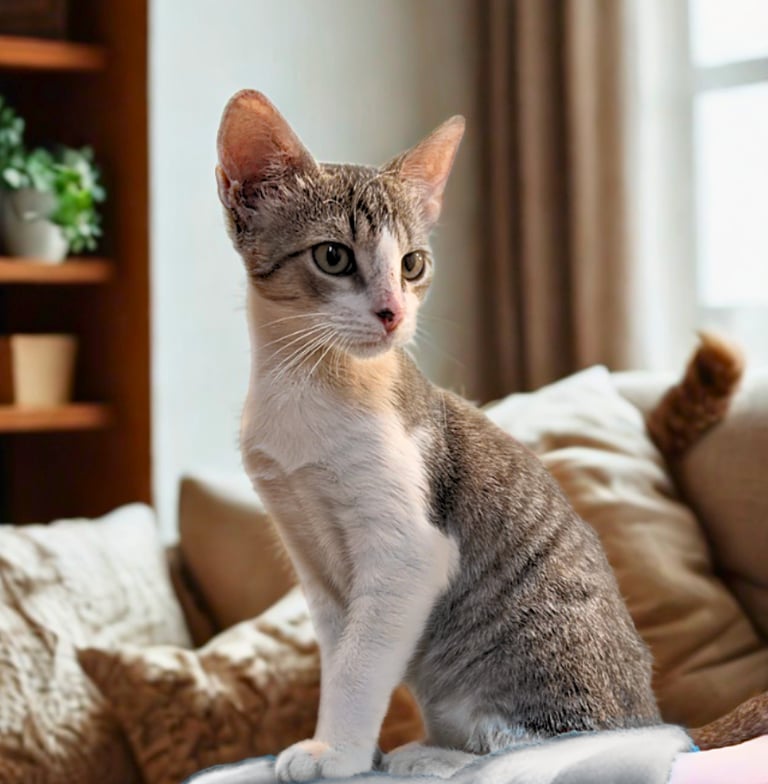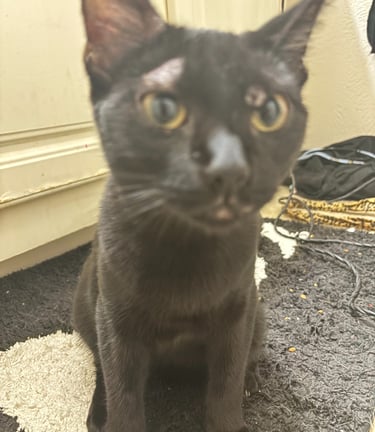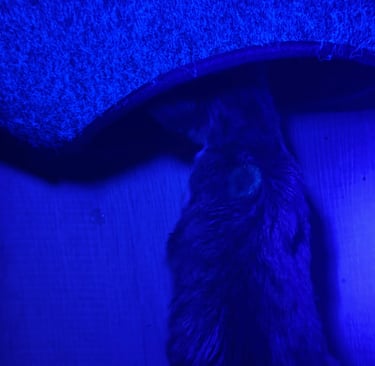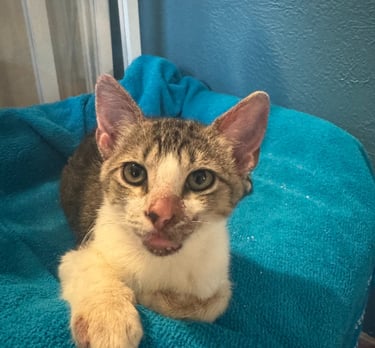Ringworm & Rescue Cats:
(No, It’s Not a Horror Movie)


Written August 2025 by Tabby Worthington, founder of Tabby's Tiny Tabbies
Affiliate disclosure:
Some links below are Amazon affiliate links. If you shop through them, a small portion supports our rescue. Thank you for helping us help more cats. 💛
My Multi-Pronged Plan (aka “The Kitchen Sink Method”)
Here’s how I handle ringworm intakes so kitties feel better, heal faster, and stop shedding spores like confetti.
1) Map the sparkles with a Wood’s lamp
In a dark room, some M. canis hairs light up a bright apple/green under UV. It’s a super handy screening tool—but not every case fluoresces, so we don’t rely on this alone. [6, 7, 12]
My pick: Wood’s Lamp UV Detector.


Flow picked up Ringworm from Memo after sneaking into his quarantine space for an unauthorized playdate.
Memo had the worst case of Ringworm I've ever seen when he first came into the rescue, but he's recovered well after just a little bit of TLC and regular cleaning with the right products, plus good nutrition.


2) Treat from the outside in
Lime sulfur dips twice weekly. It smells like rotten eggs and victory—and it’s got residual activity on the coat that helps a ton. Classic Lime Sulfur Dip. [4]
Medicated shampoos (miconazole/ketoconazole) to reduce surface contamination. I rotate between these based on what I have on hand: Veterinary Antifungal Shampoo and Davis Miconazole Shampoo. [1, 9]
Spot treating small lesions with clotrimazole cream (zinc-free) if a vet okays it—cone baby if they try to lick. (Not every case needs this.)
3) Treat from the inside out
Some cases need an oral antifungal (usually itraconazole or terbinafine) prescribed by your vet. Topical + systemic is a very normal combo for widespread or stubborn infections. [1, 5]
4) Keep the skin happy while it heals
I gently comb out loose hairs after baths to help meds reach skin. For moisture, I keep it simple and vet-guided—no heavy scents, and avoid anything not cat-safe. (When in doubt, ask your vet.)
5) Stay consistent
Ringworm is a “slow and steady wins the race” situation. Many protocols continue treatment until confirmed resolution (your vet may recommend follow-up cultures or continued therapy past visual healing). [1]
Home & Hygiene (a.k.a. “Winning the Spore Wars”)
Laundry: Hot wash for bedding, towels, soft carriers. Add a disinfecting laundry additive if your vet recommends it. [6, 10]
Surfaces: Vacuum, then disinfect. A 1:10 bleach solution on bleach-safe surfaces is classic; pet-safe disinfectants can help elsewhere. [8, 10]
Clothes & skin: I wear “ringworm room” clothes, then wash arms to sleeves (and any skin kitty touched). Quick outfit change on exit. It’s a fashion show—just not the Met Gala.
Air handling tip: Field data from shelter medicine shows furnace filters trap spores—use high-quality ones and change them regularly. [11]
Medical disclaimer: I’m sharing what works in rescue with support from veterinary resources, but I am not your cat’s veterinarian. Partner with your vet for diagnosis and treatment for your specific cat.
The Exact Products I Use (Affiliate Links)
Shopping through these links helps fund formula, meds, and spay/neuter for future intakes. Thank you. 💛
References (numbered)
ABCD (European Advisory Board on Cat Diseases). “Dermatophytosis (Ringworm) in Cats — Guidelines.” Recommends topical rinses (enilconazole or miconazole/chlorhexidine) and systemic itraconazole/terbinafine when indicated. https://www.abcdcatsvets.org/guideline-for-dermatophytosis-ringworm-in-cats/
ABCD Fact Sheet. “Dermatophytosis in Cats.” Overview & clinical notes. PDF
Cornell Feline Health Center. “Ringworm: A Serious but Readily Treatable Affliction.” Typical durations and use of dips when lesions are widespread. Link
HumanePro (HSUS). “Ask the Expert: Ringworm treatment.” Outside-in (lime sulfur) + inside-out approach. Link
Frymus T, et al. “Dermatophytosis in Cats: ABCD guidelines on prevention and management.” J Feline Med Surg (2013). PubMed
VCA Animal Hospitals. “Ringworm in Cats.” Diagnosis (including Wood’s lamp limits) and general care. Link
UW Shelter Medicine. “Accuracy of Wood’s Lamp Exams for Diagnosing Dermatophytosis.” What a true positive looks like; limits and interpretation. Link
Cornell University (Shelter/Cattery guidance). “Management of Ringworm Infections in Catteries.” Notes bleach 1:10 as cost-effective disinfectant on appropriate surfaces. PDF
Maddie’s Fund. “How Animal Shelters Are Beating Ringworm (Audience Q&A).” Practical protocols from shelter medicine. PDF
Cornell Feline Health Center. “Zoonotic Disease—What Can I Catch from My Cat?” (environmental & hygiene context). Link
Maddie’s Fund (handout). “How Shelters Are Beating Ringworm.” Field note on furnace filters trapping spores. PDF
Mrazkova K, et al. “Reliability of using Wood’s lamp by shelter personnel…” (2023). Proportion fluorescing & limitations. PMC
Let’s clear this up fast: ringworm isn’t a worm. It’s a treatable skin fungus that’s closer to athlete’s foot than anything from a sci-fi channel marathon. Is it contagious? Yes. Is it manageable with basic hygiene and a simple treatment plan? Also yes. And adopting a cat with ringworm can literally save a life—because too many shelters still treat it like it's proverbial playground cooties. [1, 4, 6]
Quick Nav
Myths vs. Facts
“Ringworm is rare and super dangerous.”
It’s common in cats (especially kittens) and usually mild. With consistent care, they recover. Promise. [5, 6]“If I adopt a ringworm cat, I’ll definitely get it.”
Transmission can happen, but basic hygiene (wash hands/arms, change clothes, hot laundry) knocks the risk way down. [6, 10]“Treatment takes forever and costs a fortune.””
Most cases clear with a few weeks to a couple months of consistent care. Shelters and vets do this every day. [3, 4]
The "ring" in ringworm refers to the shape of the fungal colony. You know how you see "fairy circles" out on a walk when there are mushrooms in the grass? Same deal.


Poor Memo was a super crusty, itchy guy.
